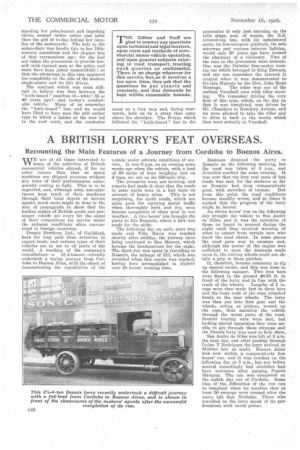TRANSPORT HISTORY IN PAGEANTRY.
Page 67

Page 68

If you've noticed an error in this article please click here to report it so we can fix it.
An Effort to Revive Memories and to Bring Home, by Contrast, the Development of Transport.
TEW Lord Mayor's Show in London is not always so interesting from the point of view of transport as it was this year, although transport, naturally, plays an important part in a procession that may be a mile long and that has to cover a distance of four or five miles in the perambulatory route from the G'uddhall to the Law Courts and back. It is a strange survival, this procession of the new Lord Mayor to take the oath in the Lord Chief Justice's Court. because it involves much dislocation of traffic for three or four hours, yet it is suffered with great good-humour and even with appreciation, and perhaps the confirmed grumbler would be the last to suggest that the civic head of the Metropolis should, fdr the sake of economy and public efficiency, slip up to the Law Courts and back in a taxicab. The feature of this year's show, which appealed to the fancy of the many thousands of onlookers, was the display of transport from early days to the present, and we must say that the committee responsible for it was far more successful than we had anticipated, for a few ancient specimens were actually gat to run—the point on which the display might easily have broken down. The Times is delightfully humorous in its description of the exhibits, and says that the lessons of the contrasts presented were not to be missed. Transport has developed from the man with the bundle, through the pack-horse, the wheeled barrow and the horsed vehicle to more recent and present-day methods and each advance has followed upon an improvement in road conditions and has cried for further improvement. The eternal conflict between the shell and the armour-plate is repeated in transport and highway, and neither conflict seems ever to reach the position at stalemate where neither antagonist can make further progress. The Times says that the stage-coach drawn by four horses, with Pickwick and his friends perched atop, lookeri so handsome, genial and gay a method of bowling through
• country lanes that many of the spectators, hugging the recollection of Dickens's descriptions, were in danger of seeing in the motor saloon that followed an unromantic kind of vehicle. Fortunately, in the interests of drab tfuth, the rain intervened ; and the sight of Mr. Pickwick without a mackintosh on the box-seat most chillingly redressed the balance. On the other hand, the woman on the horse-pillion. ,notwith standing her polakbonnet and impeding skirts, seemed rather easier and .safer than the girl of to-day behind her cavalier of the motorcycle. The lady in the sedan-chair was hardly fair to her 18thcentury ancestress and the elegant box of that ceremonious age ; for she had not taken the precaution to provide herself with trained men at the poles, and must have been jolted unmercifully; so that the advantage in this case appeared too completely On the side of the modern single-seater and its fair driver.
The contrast which was most difficult to believe was that between the "knife-board" omnibus of—what ! 35 or 40 years ago?—and to-day's comfortable vehicle. Many of us remember the " knife-board" bus, and we would have liked to have seen the still earlier type in which a ladder at the rear led ,to the roof seats, and the conductor stood on a tiny step and, facing rearwards, held on by a strap that came above his shoulder. The B-type which followed the " knife-board " bus in the
procession is only just entering on the relic stage, and, of course, the N.S. covered-top In's, with its upholstered seats, its low-entrance platform, its safe stairway and copious interior lighting, would only 20 years ago have seemed the phantasy of a visionary. Two of the ears in the procession were historic. One was the Daimler four-seater touring car which belonged to King Edward, and one can remember the interest it created when it was demonstrated to his late Majesty by the Hon. 3-ohn Scott Montagu. The other was one of the earliest Vauxhall cars with tiller steering. We remember driving the very first of this type, which, on the day on that it was completed, was driven by Mr. Chambers to Rosebery Avenue, and we were allowed to take the tiller and to drive it back to the works which then were actually at Vauxhall.












































































































